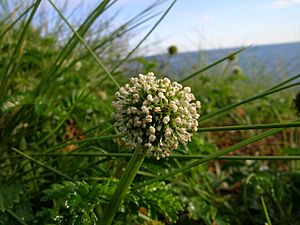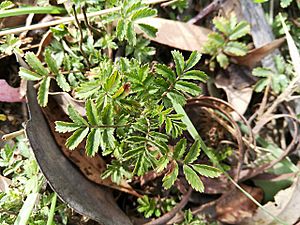Red bidibid facts for kids
Quick facts for kids Red bidibid |
|
|---|---|
 |
|
| Scientific classification | |
| Genus: |
Acaena
|
| Species: |
novae-zelandiae
|
The Acaena novae-zelandiae, often called red bidibid, bidgee widgee, buzzy, or piri-piri bur, is a small plant. It's a type of herb that lives for many years, meaning it's a perennial. This plant is native to New Zealand, Australia, and New Guinea. It belongs to the Rosaceae family, which also includes roses!
Contents
What Does Red Bidibid Look Like?
Red bidibid is a small plant that grows close to the ground. It has stems that spread out, called stolons. These stems are about 1.5 to 2 millimeters thick. If a stolon gets damaged, the plant can grow new shoots from that spot.
Leaves of the Red Bidibid
The leaves of the red bidibid are special. They are called imparipinnate, which means they have a central stem with smaller leaflets branching off, and there's one leaflet at the very end. Each leaf has 9 to 15 small, toothed leaflets. These leaflets are about 2 to 11 centimeters long.
The top side of the leaves is a shiny, dark green. The bottom side is a dull, bluish-green color and feels hairy. The main stem of the leaf, called the rachis, is often red.
Flowers and Seeds
The plant grows a stem called a scape, which is about 10 to 15 centimeters tall. At the top of this stem is a round cluster of 70 to 100 flowers. This cluster is called an inflorescence and is about 20 to 25 millimeters wide.
The flowers are small and don't have petals. They can be green, white, or purple. Wind helps to pollinate these flowers.
Each flower produces one small fruit called an achene. This fruit has four sharp spines, each about 10 millimeters long. These spines have tiny barbs on their tips, like a fishing hook. When the fruit is ripe, these spines are red, but they turn brown later.
How Red Bidibid Spreads Its Seeds
The spiny fruits are very good at sticking to things! They easily attach to animal fur, bird feathers, and even your clothes. This is how the plant spreads its seeds to new places. It's a clever way for the plant to travel!
Where Does Red Bidibid Grow?
Red bidibid naturally grows in New Zealand, Australia, and New Guinea. But it has also started to grow in other places, like California, Great Britain, and Ireland. In some areas, like the sand dunes in Great Britain, it's considered an invasive plant because it spreads so easily.
This plant can live in many different places, from woodlands and shrublands to grasslands. You can find it from coastal areas all the way up to high mountain regions. It likes soils that drain well, like sandy or silty soils, and places that get a lot of sunlight. You might also see it growing easily on disturbed areas, like along roadsides.
Uses of Red Bidibid
Red bidibid can be used in gardens as a ground cover, like a living carpet. Some people even use it as a substitute for a lawn. If you want to stop it from spreading too much, you can try to avoid disturbing its stolons. Also, mowing the flowers before the spiny burrs form can help prevent new seeds from spreading.
Some people have also suggested that the dried young leaves of this plant can be used to make a type of tea.


